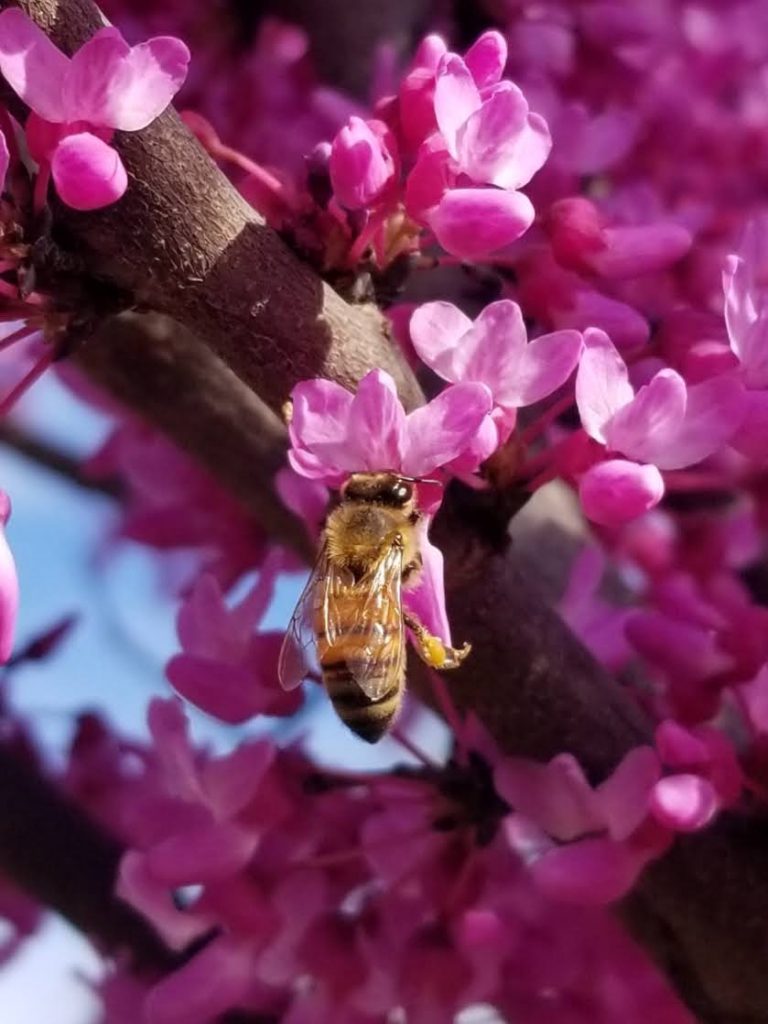
No matter the month, Oklahoma weather can be wacky! For example, as I write this post, it is the first of March and winter is slowly releasing its grip, making way for warmer temperatures. But, Spring has not yet “sprung”! As a reminder: last week we saw high temperatures in the mid-80s then a cold front blew through the area and our lows dipped to mid-20s.
Someone recently asked, “How are your bees handling these temperature swings?” My response: bees are resilient creatures and as long as I can help them maintain adequate food supplies, a warmer-ish shelter and pest-free environment, they will survive. But, the early buildup of brood requires special attention.
With these warm temperature swings, the colony starts their spring buildup: the queen begins laying eggs in anticipation of a spring nectar flow and foragers are scavenging for bits of pollen to provide the protein requirement for brood development. When we have temperature dips, protein is required for energy to generate heat and keep the brood warm.
What are some things I can do to prepare the colony for the eventual break in winter’s cold grasp and set the stage for a successful spring honey crop and healthy and productive bee colony?
Consider removing the hive’s outermost winter protections
I have standard Langstroth hives made of standard board thickness. These do not provide adequate insulating value so I wrap my hives first with tar paper then with insulation batts. Realizing we will continue to have temperature swings for at least the next 6+ weeks, I leave tar paper on the hive but remove the outer insulation batts. The tar paper continues to provide a wind break and the black color allows for thermal conductive heating when we have days of full or partial sun. The entrance reducers will remain in place to minimize the opportunities for robbing activities and other pests like mice.
Perform minimal inspections
Visual hive inspections are critical to ascertain the health of the colony. But, I want to be strategic when I open the hive to minimize heat loss. Planning my inspection allows me to be efficient. While I will not do a deep, full inspection there are several key details I want to investigate:
- Queen Health: Look for indications the queen remains in good health: visual identification of the queen, existing brood, brood pattern and the colony’s temperament.
- Disease Check: Look for any signs of disease within the hive.
- Food Stores: Confirm the colony has sufficient food stores – pollen (bee bread) and nectar (honey).
Consider feeding the bees
Late winter and early spring brings unpredictable and fluctuating temperatures. This impacts the bees’ ability to forage and gather food. For this reason, it may be necessary to supplement the colony’s food supply. These supplements can be in the form of sugar syrup, candy boards, pollen patties and fondant. Food supplements help mitigate a decline in the colony’s health and allows for ongoing brood development which is essential for the colony’s expansion and health.
Monitor space needs
While we have not entered into our first nectar flow, I must be mindful of the colony’s need for adequate space. As the queen begins her brood buildup with egg laying and as the foragers are able to bring in pollen and nectar (however scarce), space can become confined. This confinement can trigger an early swarm. If your management style allows for or encourages swarms, then you may not be as concerned; otherwise, be vigilant about providing sufficient space and resources for the growing colony. When I see drone comb, I am keenly aware that swarm season is quickly approaching. If weather and resources allow, I will consider early splits.
Take good notes!
Record keeping and note taking is an important part of my apiary management. My documentation allows me to be more proactive and helps with planning. I can be better informed when making decisions for both individual hives and for the apiary. I encourage you to start a journal of your beekeeping experiences.
Conclusion
The decisions I make at this time of year help set a foundation for successful hives. The bee colonies can have a strong foundation of good health and a strong brood. It is an investment – of time, energy and resources – that pays dividends in the forms of a productive apiary and a satisfied beekeeper!